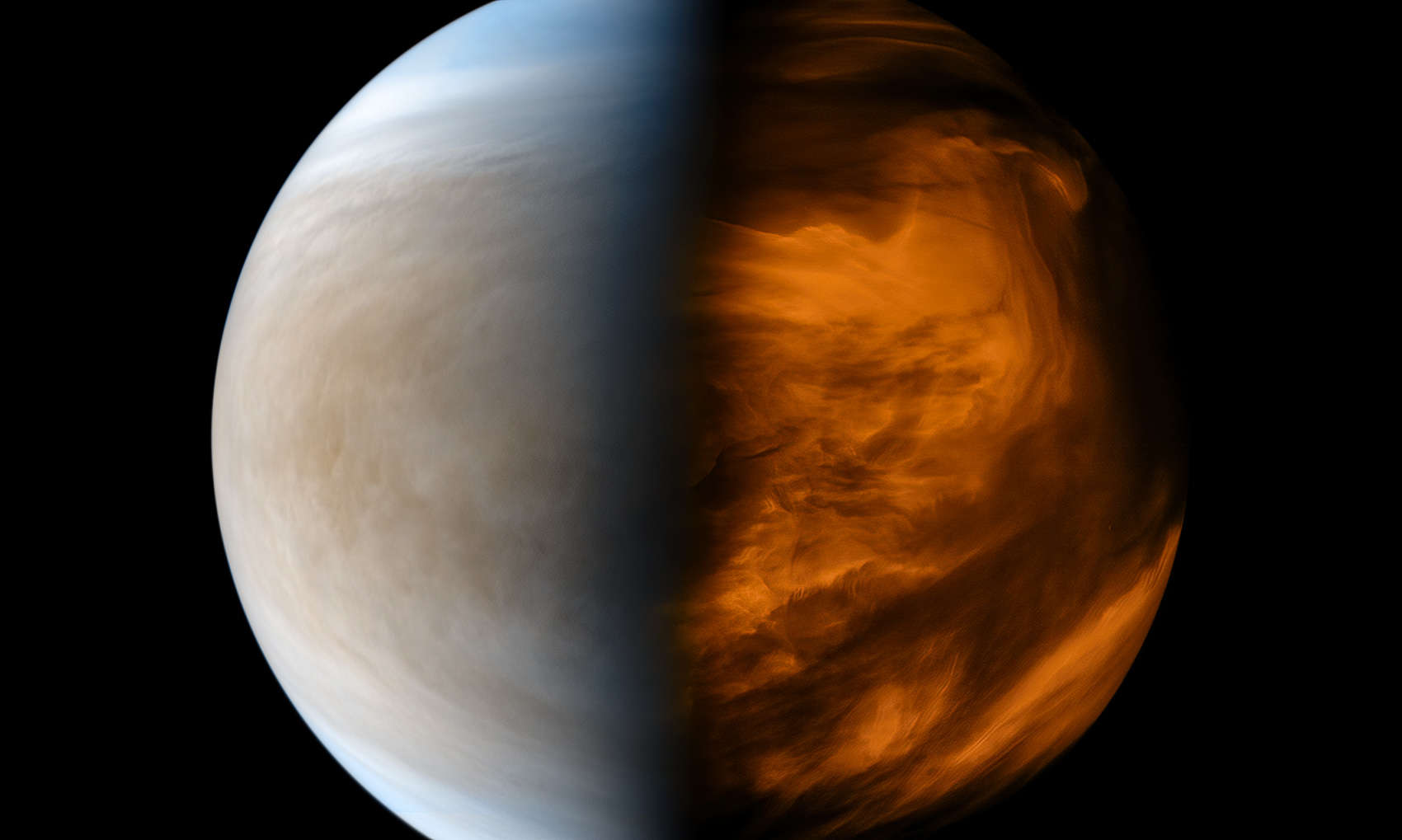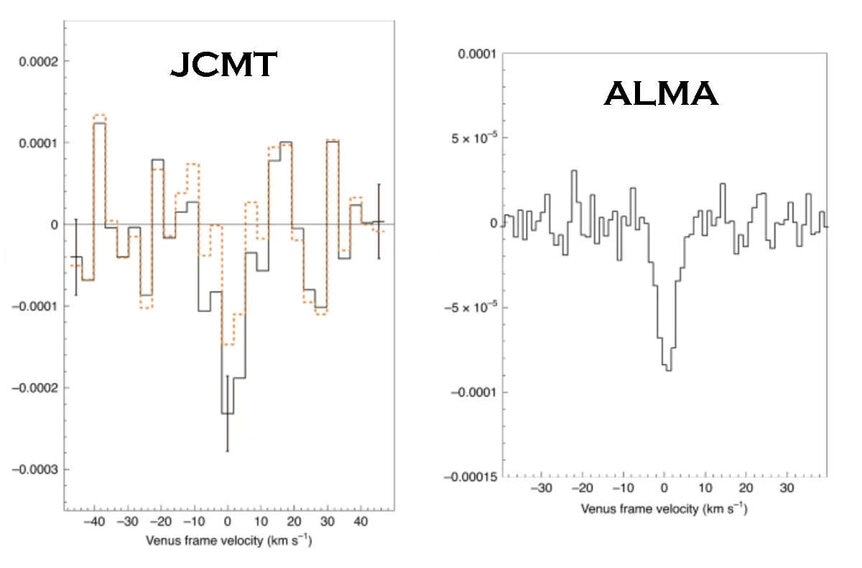Create a free profile to get unlimited access to exclusive videos, sweepstakes, and more!
UPDATE: Life above hell? Serious doubt cast on Venus phosphine finding

In September, a team of astronomers made a startling announcement: They had detected the signature of a gas called phosphine in the atmosphere of Venus, a chemical that, on Earth, is created by life. Venus has no known non-biological way to produce this molecule in the quantities observed. Had they found evidence of life in the clouds of Venus?
It was a big announcement, prompting other scientists to take a look at the claim as well (in fact, the original team asked for and welcomed it). It’s been a few weeks now and reports are coming… and they cast serious doubts on the reality of the detection.
The team’s initial observations of Venus were made using the James Clerk Maxwell Telescope (or JCMT) in Hawaii, which looks at light in the submillimeter wavelength region (far longer wavelengths than infrared but not quite as long as microwaves). Phosphine — a simple molecule of one phosphorus atom and three hydrogens, similar to ammonia — can emit and absorb light at a wavelength JCMT can detect.
They saw a dip in the light of Venus at that wavelength, indicating the molecule might be there in the Venusian clouds, absorbing light emitted from the atmosphere of Venus below it, but it wasn’t strong enough to claim a detection. So they turned to ALMA, a much more sensitive array of dishes in Chile. The data from that observatory showed the dip much more clearly. Their claims are based on that observation.
And that’s where the issues come in. The data are noisy, meaning there’s a lot of random up-and-down wiggling in the spectrum plot. There are lots of ways to trying to smooth over that noise; one common way is to fit a mathematical equation to the overall spectrum (I describe this process here). In this case they used a 12th–order polynomial, which can be problematic. It can actually try to fit the noise; in other words it can make noise look real signal.
One team of astronomers looking at the original data claims that in fact this is what happened. Using the same methodology they find several other dips in the spectrum that look real when in fact they are just noise.
To be fair, that doesn’t mean the signal isn’t real, but it casts serious doubt on that reality. Science writer Michael Greshko ran through various fits and showed how the graph changes:
Commenting on this, astronomer David Kipping points out the dip looks real and persistent through the various methods of fitting, but that particular fit used by team does seem to amplify it.
But it gets worse. In a footnote in their paper, the team that reprocessed the ALMA data states that there’s an issue with the data calibration pipeline used. When observations come from a telescope, they need to be processed before analysis to remove artifacts introduced by the telescope and detector (for example, a visible-light camera might be more sensitive to red light than green, so that needs to be accounted for). This can be done automatically if all the factors are known, and in fact that’s the usual procedure.
If that pipeline processing has an issue, that can mess with the data. In this case the second team says the dip in the spectrum goes away in the new processing pipeline. It’s not clear if this new method is accurate or not, so people at ALMA are looking into this to see. If the new processing is correct, then the detection goes away. So it’s important to understand this.
There’s yet another issue. At the time of the original announcement, I wrote this:
However, while the observations were good, they weren't convincing, so the team got time on ALMA, another millimeter telescope in Chile that is larger and more sensitive than JCMT. The data from that were far clearer, again showing absorption at the right wavelength for phosphine.
To their knowledge, no other molecule or atom could absorb at that specific wavelength. Still, to be clear, finding a single absorption feature in the spectrum is a little bit iffy. I'm reasonably convinced they found phosphine, but I'd be happier if they found it at different wavelengths as well [emphasis new]. They do plan on observing more to look for it.
Atoms and molecules absorb light at multiple wavelengths, so if you think you’ve found it at one wavelength, it’s best to look for it at the others, too. So another team observed Venus with the Infrared Telescope Facility in Hawaii to look for phosphine at a different wavelength, specifically about 10 microns. They didn’t find anything there.
[In the plot in that tweet, the models of phosphine are in the colored lines, and the data are the I-shaped points; no phosphine is seen.]
To be fair again, in that wavelength of infrared they see the cloud tops of Venus. If the phosphine were lower down in the atmosphere, they could miss it.
So is there phosphine in the atmosphere of Venus or not?
Well, right now no one can say. It’s possible, but the original observations may be faulty, and follow-up observations didn’t see it but could have missed it. For me this means we need to be even more skeptical of the original finding, though not necessarily dismissive. It might yet be correct, though the odds of that are now significantly lower.
From what I’ve read the original team welcomes this analysis. They knew and know how big this result could be — in fact I was pleased with how skeptical they were with their own claims; I corresponded with lead author Professor Jane Greaves several times as I wrote my article, and she spent quite a bit of time trying to figure out where they might have been wrong.
As for the possibility of life on Venus, I think they handled themselves well there too, being fairly circumspect about that conclusion. Astronomer Sara Seager went so far as to present a slide in the press conference that literally said “We are not claiming we have found life on Venus.”
Some people might find this story a reason to cast doubt on the entire scientific process, if not just this one aspect of it. But I strongly disagree.
I think this all emphasizes just how hard this all can be. If it were easy then it would’ve been seen long ago! This sort of thing happens a lot with cutting-edge observations, actually. Someone makes a claim, and then others jump on it and see if they can support or negate it. That’s how science is supposed to work. If we don’t vigorously (and rigorously) interrogate the results, how will we know if we’re right or not? A lot can go wrong along the way of going from observations to conclusions, and the scientific method makes sure we minimize those issues.
So now what? The best bet now is to see about the effect the calibration pipeline has on the ALMA data. If it turns out the new pipeline is over-vigorously scrubbing the data, then maybe more time on ALMA to get better data would be nice. More observations at other wavelengths are crucial too.
And hey, Venus is a pretty interesting place for a lot of reasons besides possible phosphine in its atmosphere. I’d love to see more spacecraft sent there to see if it’s still geologically active, to find out why its atmosphere is so thick and when that happened, and much more.
There’s a lot going on at our sister planet. It’s well past time we took a closer look.
















